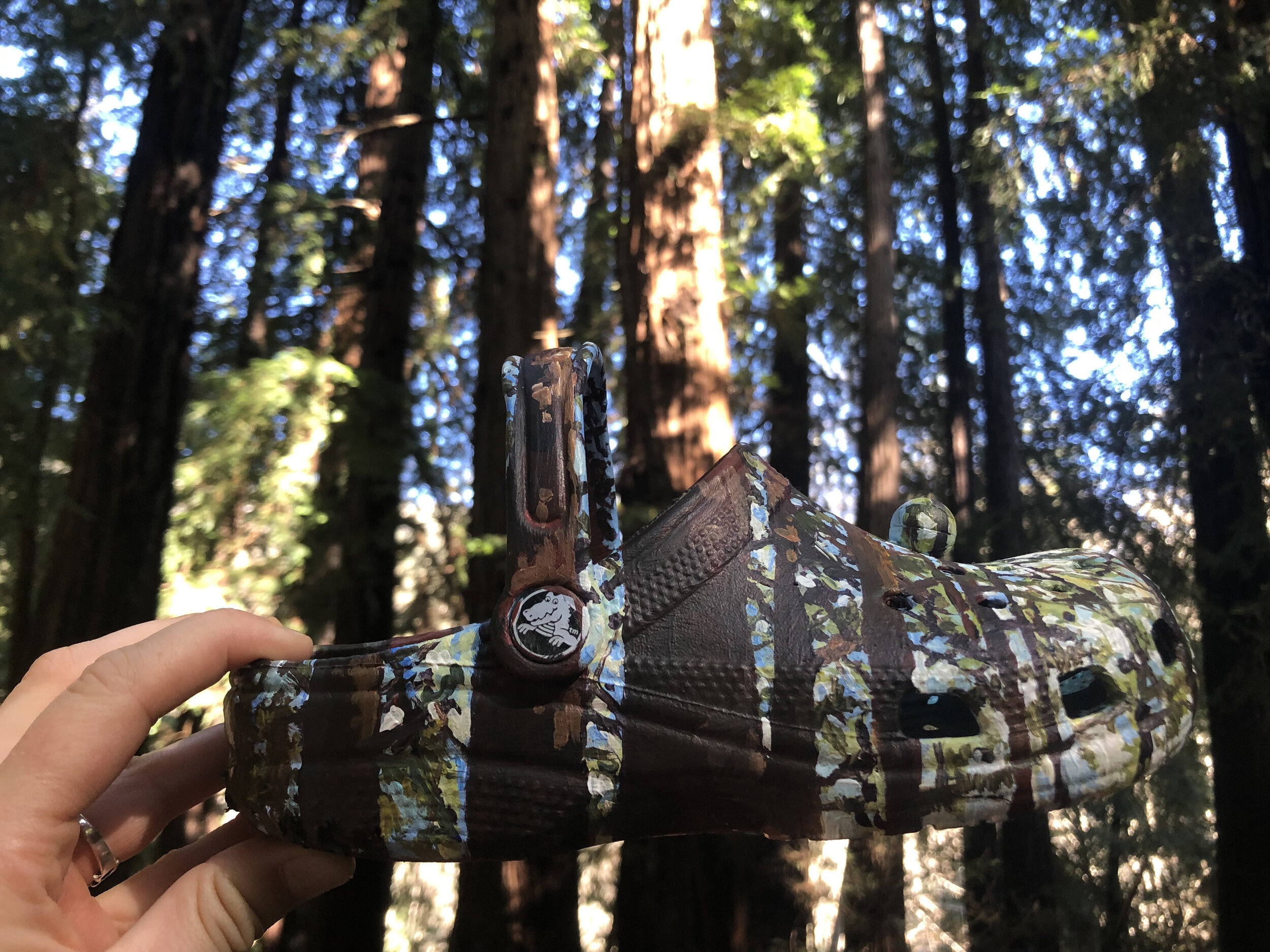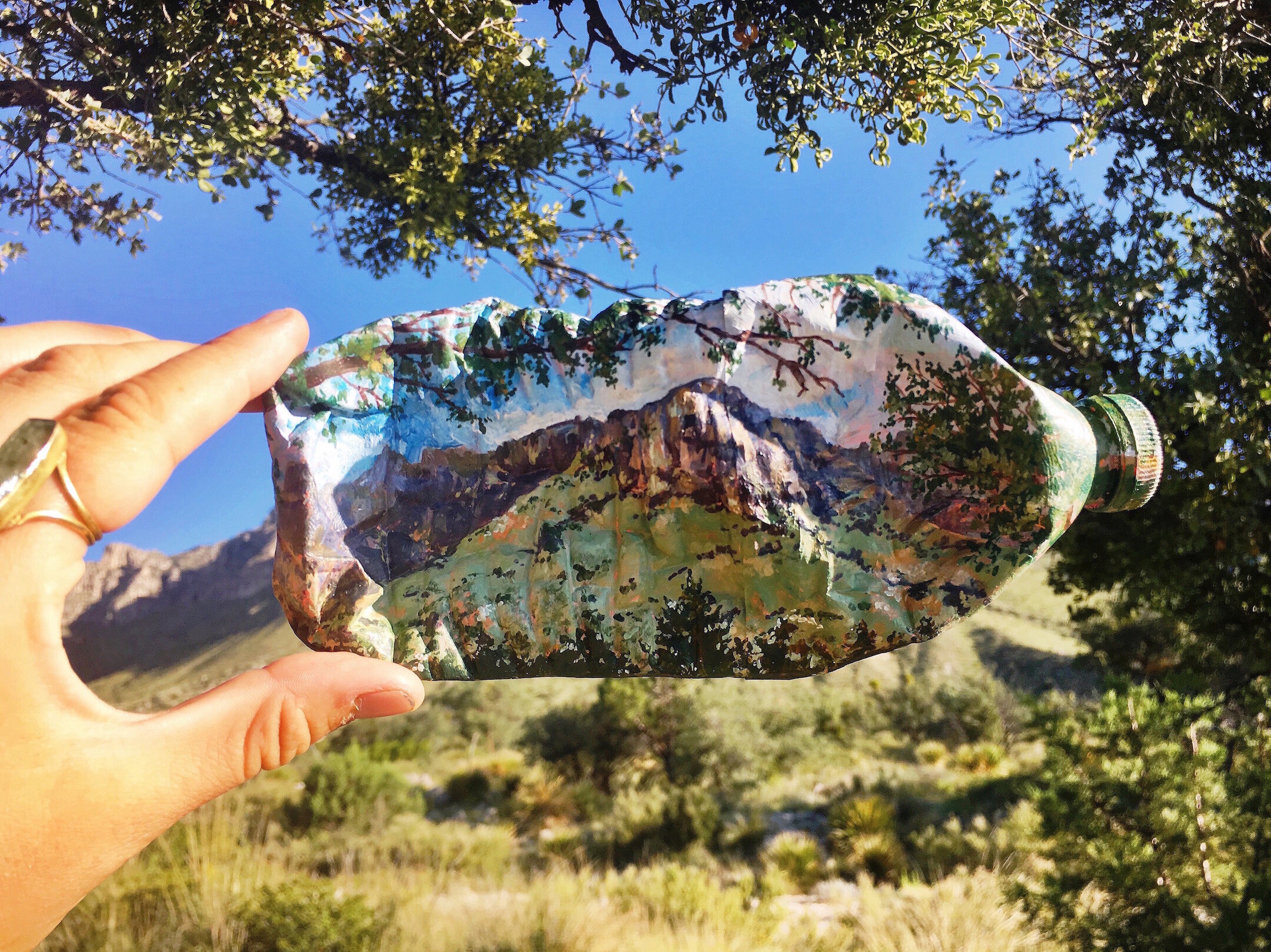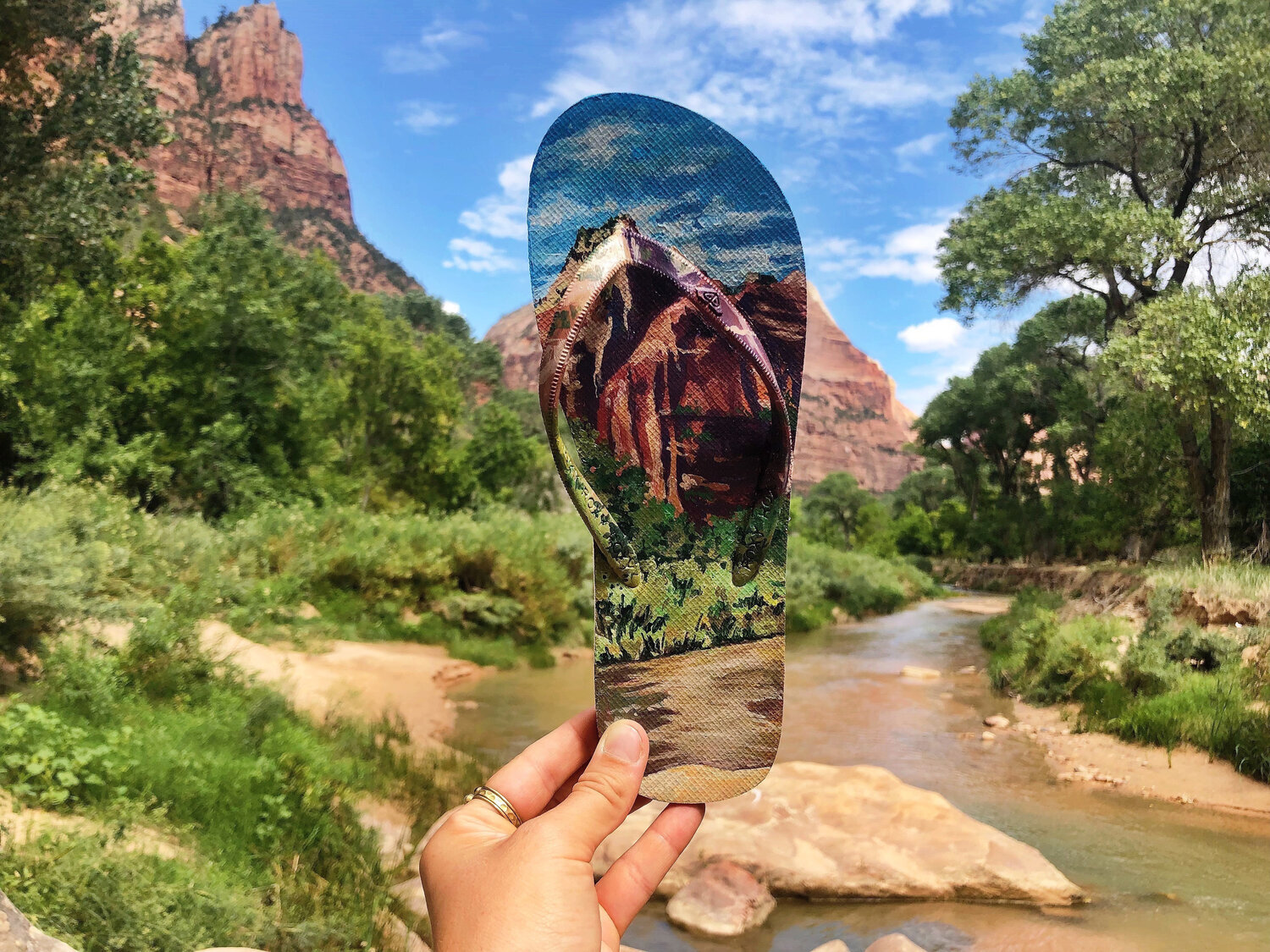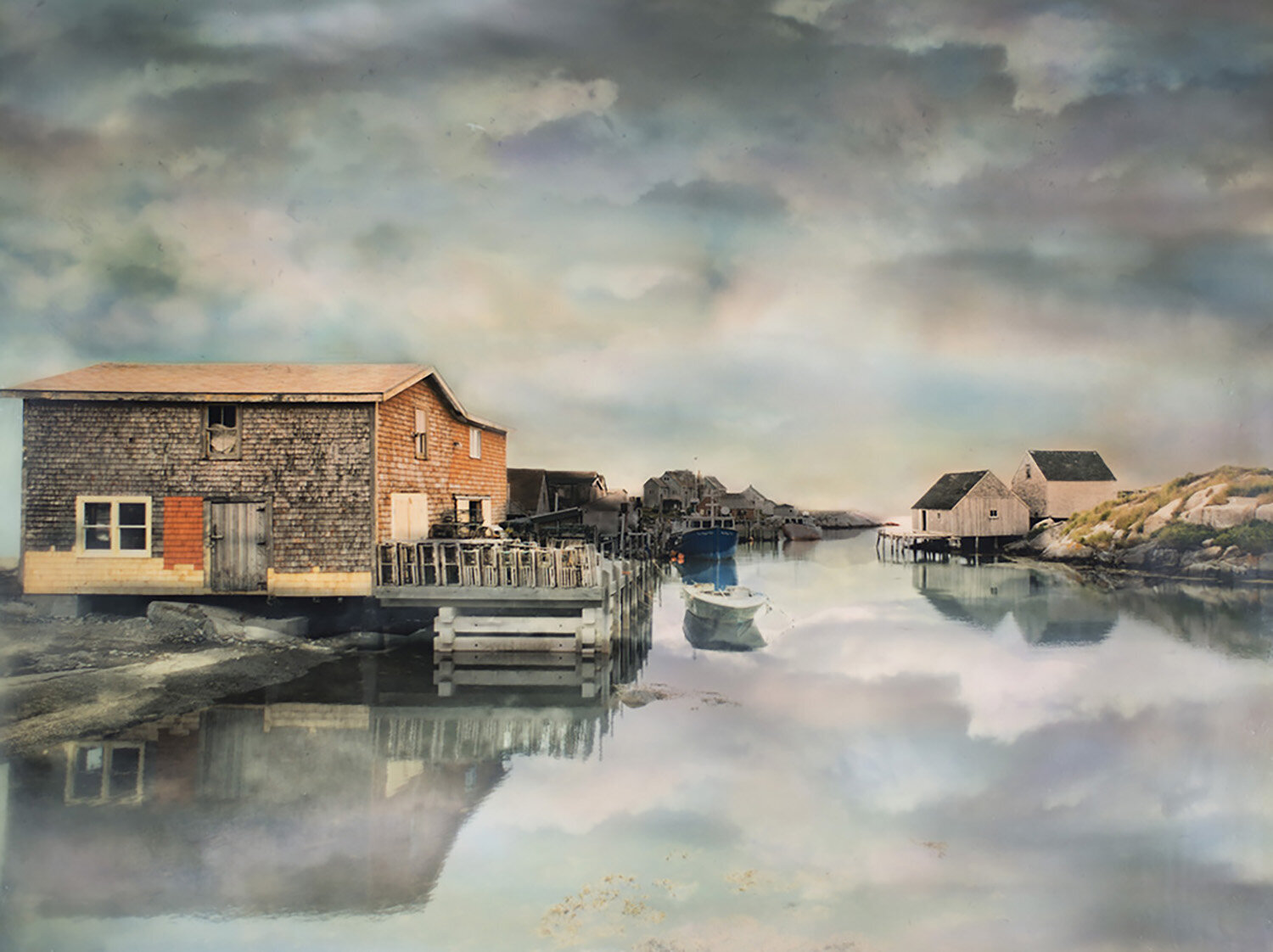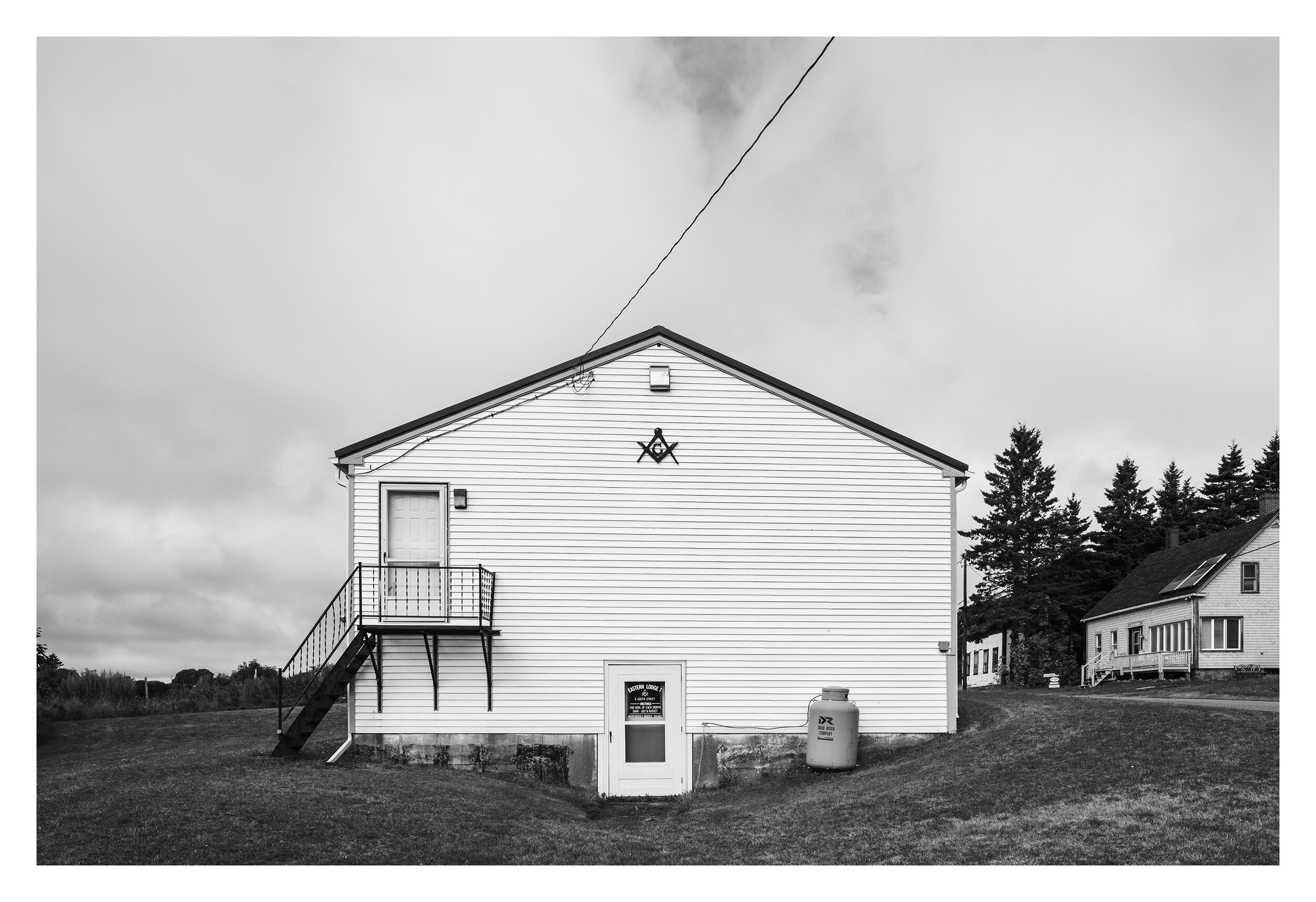Environmental
Mariah Reading
Mariah Reading, Glove Cove, Acrylic on gloves and mittens found throughout the winter, sewn and stretched around recycled canvas bars. Wabanaki Confederacy Land, 2021, Inkjet print, 20 x 16 inches
Mariah Reading is an eco-artist from Bangor, Maine. Throughout her travels to native lands, Reading creates impressionist paintings on trash in order to depict the harms of pollution and climate change.
I have been contemplating my relationship with art and the vast amount of waste creating it can produce. Classically trained as a landscape painter, I pivoted to eco art when the parallel between painting landscapes and feeding landfills became overwhelmingly apparent. The landscapes that so richly inspired me were being hurt by the waste I created in order to depict them. To rectify this unwanted connection I have developed a zero waste practice that involves creating canvasses from debris found during my travels through National Parks and protected landscape environments. The physical pieces of trash are painted only on one side and intentionally left untouched on the reverse so the original piece of debris remains evident. Once completed, the painted object is aligned with the physical landscape to both obscure and highlight the discarded object. In the wake of the longest ever government shutdown, it is now more critical than ever to leave no trace. When our public lands are not vigilantly protected, the detrimental effects cannot be ignored. These wild spaces can easily be taken for granted, as even the most remote of such are becoming paved and overrun with idling personal vehicles. My practice revolves around ways I can lessen my footprint upon Earth and leave it better than I found it.
– Mariah Reading
View more of Mariah’s work on her site, www.mariahreadingart.com
Jane Page
Jane Page-Conway, Pond Lillies, 2020, Infared , Inkjet print, 11 x 14 inches
Jane Page-Conway, Blue Moon Rising, Infared, Inkjet print, 12 x 12 inches
I am currently working with digital infrared photography to capture the surreality of the present moment. Infrared photography results in a peculiar, dreamlike image that enhances the tonal variations of light on landscapes, seascapes, and the flesh-tones of human skin. Anything with chlorophyll will glow bright white, water will appear translucent and cloudy skies will appear dramatic and other-worldly. At a time when so much of our regular routines have been upended and life itself feels surreal, infrared photography speaks volumes.
–JPC
View more of Jane’s work on her site, www.janepageconway.com/infrared
Montana to the Maritimes
Jaimie Ladysh Merges the Spirit of Sea and Sky with Encaustic Compositions
Jaimie Ladysh, Ethereal Waves, 2020, Photo Encaustic with Beeswax and Pastels, 16x20 inches,
This year of online workshops seemed to lead all paths to cross in one way or another. I recently took a workshop, Zen and the Art of Photography with Doug Beasley and 10 other like-minded photographers. What is it that we seek through our photography? For our little group it is something deeper than what is literally in front of us. To connect with the spirit or essence of the subject and find a way to convey that through our photographs unified us in our quest through Doug’s gentle meditative lessons during our few days together. Jaimie’s photographs reached out to me with places that I’ve never been to yet they felt so familiar and peaceful. Maybe it’s how I imagine or hope the Canadian Maritimes to be. So I reached out to Jaimie to learn how she makes these images that connect us through the ether. Jaimie graciously took time before her next workshop to describe her process in Big Skies and Water Dreams. –DD
Big Skies and Water Dreams
Big Skies and Water Dreams was born from the influence of my favorite big skies in Montana along with my love of the sounds, smells, and sights of the sea. The water images are from my favorite coastal areas of Maine, Nova Scotia, and Newfoundland. I’m creating an entirely new spiritual and dreamlike place from my two favorite geographical locations.
I begin by editing and compositing several images until I create my base image. I print and attach to a cradled birch substrate. Then I begin hand coloring with pencils, pastels, paints, and sometimes inks. Next I apply layers of beeswax and fuse with fire. This is the ancient method of encaustic. The luminosity of the beeswax gives the images a more remote-like feeling as a dream or memory. I add more pastels and sometimes paints.I use soft colors to impart a sense of tranquility and peace. –JL
Jaimie Ladysh, Spiritual Navigation, 2020, 24x12 Triptych, Photo Encaustic with Beeswax and Pigments
View more of Jaimie’s work on her site, www.jladyshphoto.com
Meeting Hall Maine
by Michelle Hauser
Michelle Hauser, Striking Bell: Quartet, (Variation One) 2020, Ziatype overprinted with cyan, 11 x 11 inches
Meeting Hall Maine records for posterity the documentation of hundreds of meeting halls found throughout the state. This photographic exploration began in collaboration with my late husband, Andrew S. Flamm (1967-2018). I’ve continued on with our shared vision to adhere to centered compositions of frontal, side or back views and to sequence the typology of structures into grids and pairings to invite comparison. Images of these lone buildings reflect our time. One that implores us to refrain from large gatherings, yet, the photographs also telegraph our human need to build structures in order to unite people together. At some sites three-quarter views of the halls were captured to evoke the experience of a particular place, while the typologies mirror the clarity of a portrait. This historic network of halls built primarily by volunteer societies are active in Maine today in waning numbers, represent the collective power of local people banding together into groups to achieve shared interests. Meeting Hall Maine aims to instill an appreciation and desire in others to preserve these vernacular structures as democratic forums for generations to come. The project also includes work that appropriates signifiers used in ritual activities taking place inside the meeting halls. Together, these three formats offer the viewer a more complete photographic description: geographic location, historical and economic origins, symbolism, and present day condition and use. The exhibition Meeting Hall Maine will be on view at the Maine Jewish Museum in Portland, through May 7th, 2021. –MH
“Funded in part by a grant from the Maine Arts Commission, an independent state agency supported by the National Endowment for the Arts.”
View more of Michelle’s work on her site, www.michelle-hauser.com
POETRY CURATED BY WILLIAM AND ANGELA MALONEY
Book collectors (15,000ish) and farmers, they own Late Light Farm in Acton, Maine
”I don’t like the word poetry, and I don’t like poetry readings, and I usually don’t like poets. I would much prefer describing myself and what I do as: I’m a kind of curator, and I’m kind of a night-owl reporter
- Tom Waits
Double - Entry Slug Sex
Margaret Atwood (1939 - )
If we could reproduce by bud
or spore, there would not be these duels.
Or if each could swivel an identical
organ into the other’s ear
while both twirled in the air
suspended from a shimmering rope
of tears and glue, like a tip-top
highwire act,
that would work. It does for slugs:
Look at those pearly eggs!
(More future lacework lettuces.)
Unless they both get stuck. That too can happen.
No help for it but chewing off
a penis. What then, humans?
If it were yours? Imagine:
The post - deed conversation: apophallation.
My turn! You bit off mine last time.
Get on with it or we’ll be here all night, fair game for the predators.
If There Were No Emptiness
Margaret Atwood (1939 - )
If there were no emptiness, there would be no life.
Think about it.
All those electrons, particles, and whatnot
crammed in next to each other like junk in an attic,
like trash in a compactor
smashed together in a flat block
so there’s nothing but plasma:
no you no me.
Therefore I praise vacancy.
Vacant lots with their blowing plastics and teasels,
vacant houses, their furze of dust,
vacant stares, blue as the sky through windows.
Motels with the word Vacancy
flashing outside, a red neon arrow pointing,
pointing at the path to be taken
to the bored front desk, to the key-shaped key
on the dangling brown leather key holder,
the key that opens the vacant room
with its scored linoleum floor a blear-eyed yellow
its flowery couch and wilted cushion
s
its swaybacked bed, smelling of bleach and mildew
its stuttering radio
its ashtray that was here
seventy years ago.
That room has been static for me so long:
an emptiness a void a silence
containing an unheard story
ready for me to unlock.
Let there be plot.









